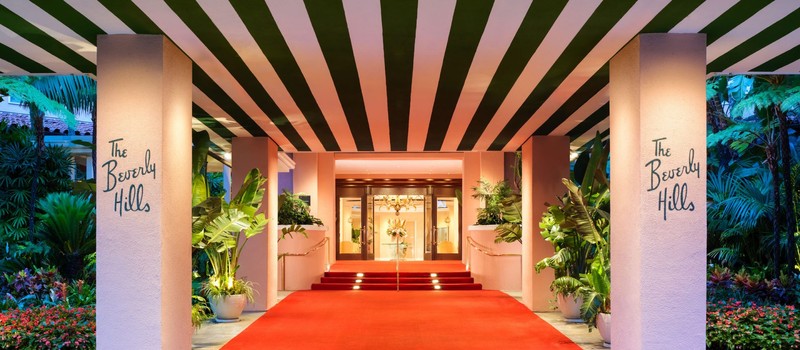Beverly Hills Hotel
Introduction
Author-Uploaded Audio
Audio by Holley Snaith
Text-to-speech Audio
Images
The entrance to the Beverly Hills Hotel

The famed Beverly Hills Hotel sign located on Sunset Boulevard

The "Pink Palace" is the architectural design of Elmer Rice

The Fountain Room coffee shop featuring the banana leaf wallpaper designed by Don Loper, known by the trademarked name "Martinique"

The Beverly Hills Hotel as it looked one year after it opened in 1912

Silent film stars Mary Pickford and Harold Lloyd at the Beverly Hills Hotel, 1921

A glamorous 1957 Cadillac advertisement staged at the Beverly Hills Hotel

Backstory and Context
Author-Uploaded Audio
Audio by Holley Snaith
Text-to-speech Audio
The story of the legendary Beverly Hills Hotel begins in 1912 when the former manager of the Hollywood Hills Hotel, Margaret Anderson, hired architect Elmer Gray to build what would become the Beverly Hills Hotel for $500,000. It was two years later that the city of Beverly Hills was officially incorporated. In 1915, the first five of the Hotel's bungalows were built, offering exclusivity for the wealthiest of visitors and stars.
From the time of its conception, the Hotel has attracted the most famous names in Hollywood. In 1919, the swashbuckling Douglas Fairbanks purchased a lodge just above the Hotel and expanded it. He and wife Mary Pickford named the mansion "Pickfair." By the late 1920s, Anderson was ready to sell the Hotel and it was purchased by the Interstate Company of New York. With the stock market crash and the onset of the Great Depression, even the Hotel was affected closed in 1933, only to be reopened a year later by the Bank of America. During the Depression, the Hotel continued to offer grandeur to the most privileged, even the infamous pool was surrounded by pure white sand the Hotel had imported from Arizona.
The 1940s saw another change of hands with the Hotel, the vice president of Bank of America, William Courtright, purchased the Hotel with celebrity friends Irene Dunne and Loretta Young, as well as Harry Warner and Joe Schnitzer. In 1948, the Hotel underwent an architectural redesign by Paul Revere Williams. Williams decided to have the Hotel painted pink and added the Fountain Coffee Room to accompany the Polo Lounge restaurant. It was then the moniker the "Pink Palace" was born.
The Beverly Hills Hotel has remained an attraction for some of Hollywood's biggest names, especially the solitary bungalows. Out of the Hotel's 23 bungalows, Marilyn Monroe preferred to stay in Bungalow 7, while Elizabeth Taylor and Richard Burton briefly lived in Bungalow 5. Howard Hughes, the reclusive aviation pioneer, director, and business magnate, was so obsessed with maintaining his privacy he occupied nine bungalows on and off for 30 years. The Hotel has also been a prime location for filming and can be seen in movies such as Designing Women (1957) and California Suite (1978).
The Beverly Hills Hotel has not been without controversy, however. It made headlines in 1986 when owner Ivan Boesky, son-in-law of the late owner Ben L. Silberstein, who purchased the Hotel in 1954, was indicted by the Securities and Exchange Commission for insider trading. Shortly thereafter, the business magnate Marvin Davis purchased the Hotel, only to be bought out the next year by what is now the Dorchester Collection. For three years, from 1992 to 1995, the Beverly Hills Hotel closed down for a $100 million renovation, to be re-opened with only more extravagance. In 2012 it was officially named the first historic landmark under the Beverly Hills Historic Preservation Ordinance, recognizing the staple the Beverly Hills Hotel has been in the city of Beverly Hills for over a century.
Sources
Beverly Hills Hotel: Timeline for 100-year history. The San-Diego Union Tribune. May 07, 2012. Accessed June 07, 2018. http://www.sandiegouniontribune.com/sdut-beverly-hills-hotel-timeline-for-100-year-history-2012may07....
Blodgett, Lucy. Beverly Hills Hotel 100 Years Of History With Hotel Ambassador Svend Peterson. HuffPost. June 01, 2012. Accessed June 07, 2018. https://www.huffingtonpost.com/2012/06/01/beverly-hills-hotel-100-years_n_1563759.html?slideshow=tru....
Green, Emily. 9 Things You Didn't Know About The Beverly Hills Hotel. Guest of a Guest. July 27, 2012. Accessed June 07, 2018. http://guestofaguest.com/los-angeles/things-we-love/9-things-you-didnt-know-about-the-beverly-hills-....
Conde Nast Traveler
Pinterest
Luxury Travel Magazine
Love Beverly Hills
Wikipedia
Martin Turnbull
Historic Hotels of the World
